1993 BUICK RIVIERA steering
[x] Cancel search: steeringPage 39 of 324
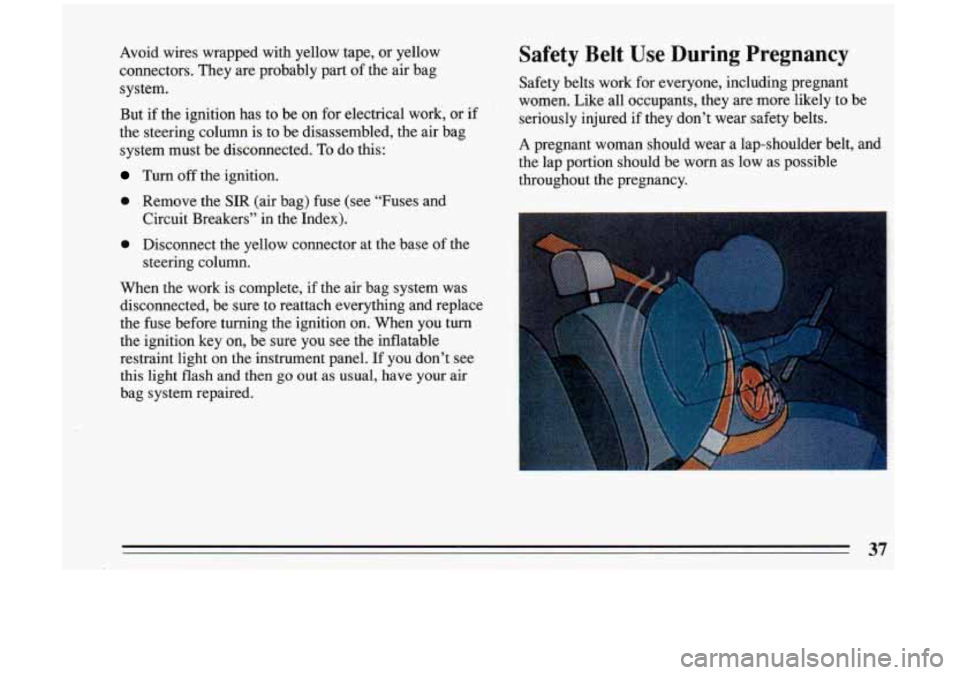
Avoid wires wrapped with yellow tape, or yellow
connectors. They are probably part of the air bag
system.
But if the ignition has to be on for electrical work, or if
the steering column is to be disassembled, the air bag
system must be disconnected.
To do this:
Turn off the ignition.
0 ‘Remove the SIR (air bag) fuse (see “Fuses and
Circuit Breakers” in the Index).
Safety Belt Use During Pregnancy
Safety belts work for everyone, including pregnant t
women. Like all occupants, they are more likely to be
seriously injured if they don’t wear safety belts.
A pregnant woman should wear
a lap-shoulder belt, and ’
the lap portion should be wok as low as possible
throughout the pregnancy.
0 Disconnect the yellow connector at the&ase of the
When the work is complete, if the air bag system was
disconnected, be sure to reattach everything and replace
the fuse before turning the ignition
on. When you turn
the ignition key on, be sure you see the inflatable
restraint light on the instrument panel.
If you don’t see
this light flash and then
go out as usual, have your air
bag system repaired. steering column.
37
Page 61 of 324
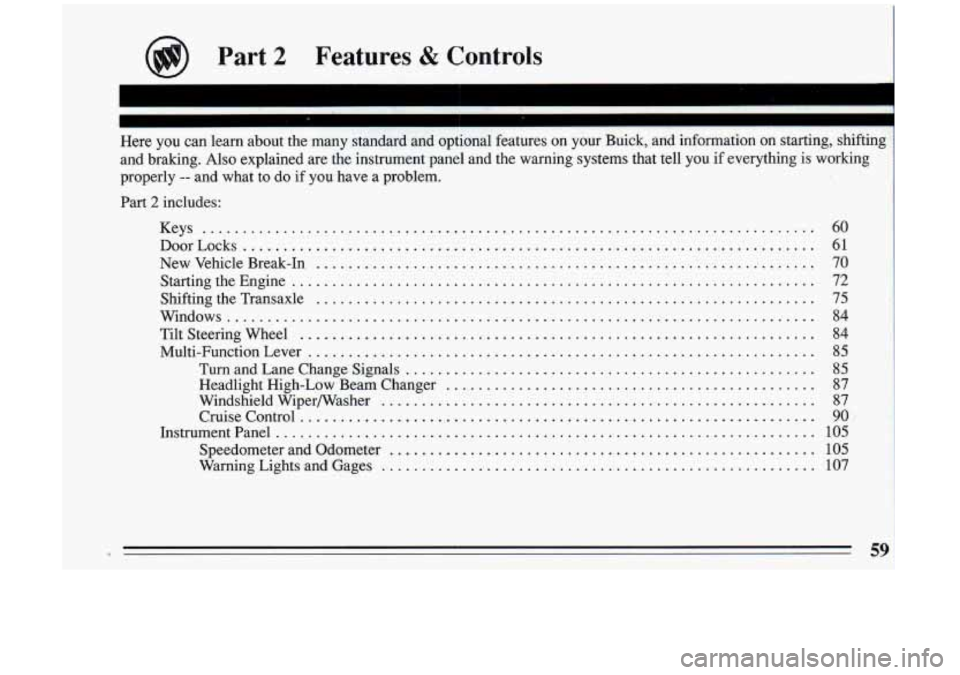
@) Part 2 Features & Controls
Here you can learn about the many standard and optional featur\
es on your Buick. and information on starting. shifting
and braking
. Also explained are the instrument panel and the warning systems that tell you if everything is working
properly
.. and what to do if you have a problem .
Part 2 includes:
Keys
........................................................................\
....
DoorLocks ....................................................................... \
NewVehicleBreak-In ..............................................................
StartingtheEngine .................................................................
ShiftingtheTransaxle ..............................................................
Windows ........................................................................\
.
TiltSteeringWheel ................................................................
Multi-FunctionLever ...............................................................
TurnandLaneChangeSignals ...................................................
Headlight High-Low Beam Changer ..............................................
Windshield Wipermasher ......................................................
CruiseControl ................................................................
Instrumentpanel ...................................................................
Speedometer and Odometer ......................................................
Warning Lights and Gages ......................................................
60
61
70
72
75 84
84
85
85 87
87
90
105
105
107
c 59
Page 68 of 324
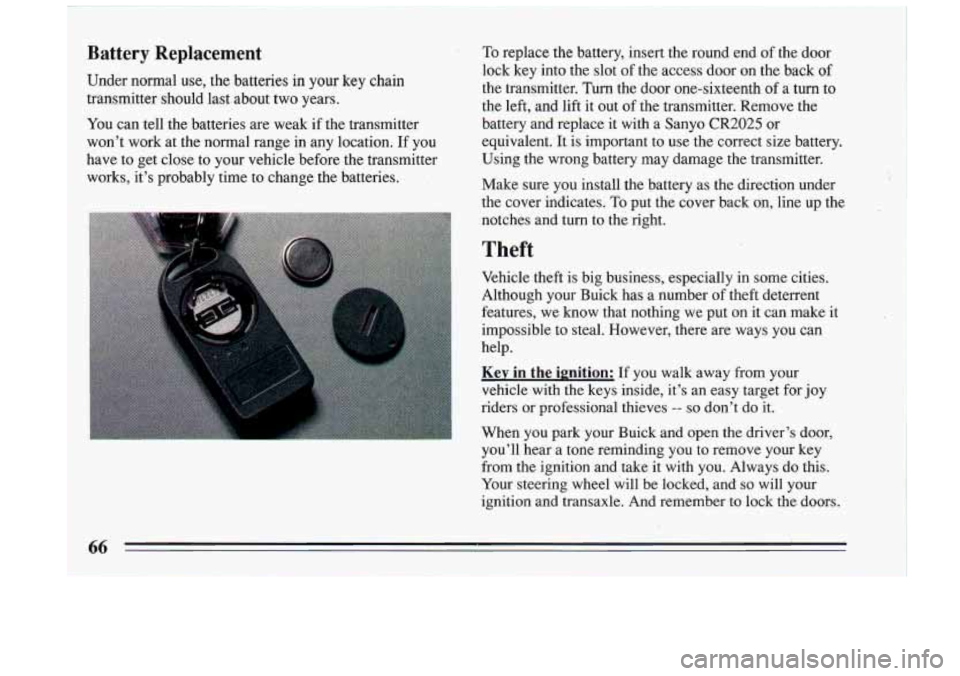
Battery Replacement
Under normal use, the batteries in your key chain
transmitter should last about two years.
You can tell the batteries are weak if the transmitter
won't work at the normal range in any location. If you
have to get close to your vehicle before the transmitter
works, it's probably time to change the batteries.
To replace the battery, insert the round end of the door
lock key into the slot of the access door on the back
of
the transmitter. Turn the door one-sixteenth of a turn to
the left, and'lift it out
of the transmitter. Remove the
battery and replace it with a Sanyo
CR2025 or
equivalent. It is important to use the correct size battery.
Using the wrong battery may damage the transmitter.
Make sure you install the battery as the direction under
the cover indicates.
To put the cover back on, line up the
notches and turn to the right.
Theft
Vehicle theft is big business, especially in some cities.
Although your hick has a number
of theft deterrent
features, we know that nothing we put on it can make it
impossible
to steal. However, there are ways you can
help.
Key in the ignition: If you walk away from your
vehicle with the keys inside, it's an easy target for joy
riders or professional thieves
-- so don't do it.
When you park your Buick and open the driver's door, you'll hear a tone reminding you to remove your key
from the ignition and take it with you. Always do this.
Your steering wheel will be locked, and
so will your
ignition and transaxle. And remember to lock the doors.
66
Page 74 of 324
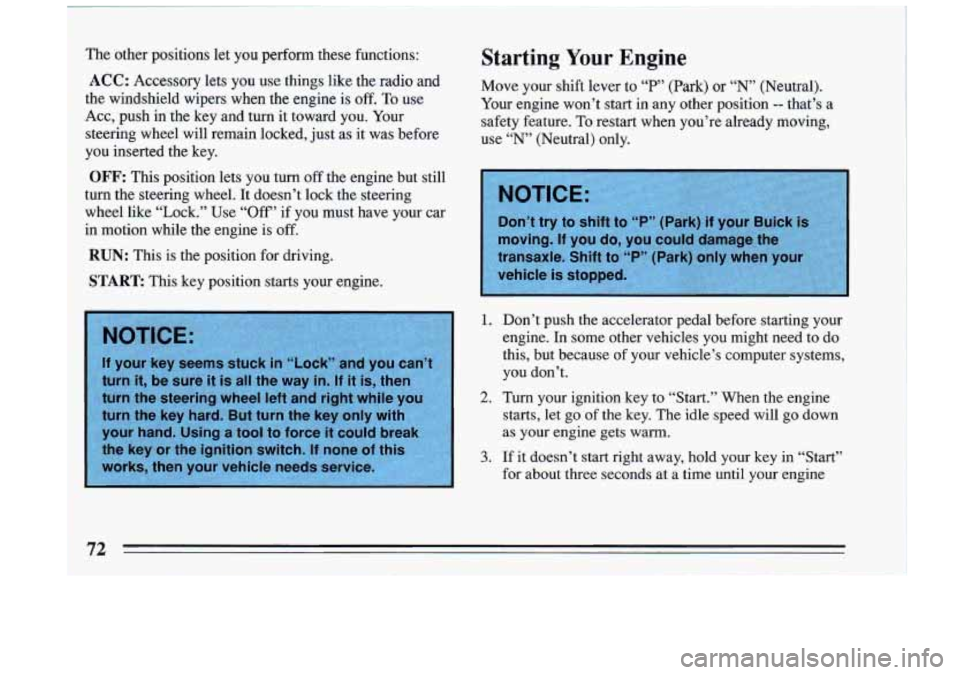
Starting Your Engine The other positions let you perform these functions:
ACC: Accessory lets you use things like the radio and
the windshield wipers when the engine is
off. To use
Acc, push
in the key and turn it toward you. Your
steering wheel will remain locked, just as it was before
you inserted the key.
OFF: This position lets you turn off the engine but still
turri the steering wheel. It doesn’t lock the steering wheel like “Lock.” Use “Off’ if you must have your car
in motion while the engine is off.
RUN: This is the position for driving.
START This key position starts your engine. Move your shift lever
to “P,’ (Park) or “N’ (Neutral).
Your engine won’t start in any other position
-- that’s a
safety feature, To restart when you’re already moving,
use
“N” (Neutral) only.
1. Don’t push the accelerator pedal before starting your
engine.
In some other vehicles you might need to do
this, but because of your vehicle’s computer systems,
you don’t.
starts, let go of the key. The idle speed will go down
as your engine gets warm.
3. If it doesn’t start right away, hold your key in “Start”
for about three seconds at a time until your engine
2. Turn your ignition key to “Start.” When the engine
72
Page 86 of 324
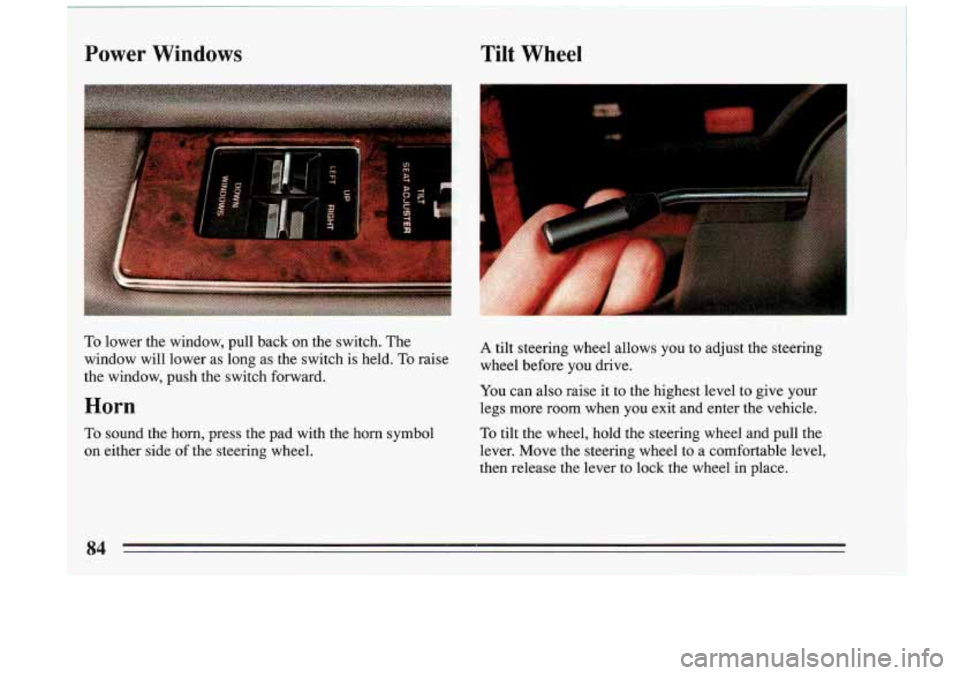
Power Windows
To lower the window, pull back on the switch. The
window will lower as long as the switch is held. To raise
the window, push the switch forward.
Horn
To sound the horn, press the pad with the horn symbol
on either side of the steering wheel.
A tilt steering wheel allows you to adjust the steering
wheel before you drive.
You can also raise it to the highest level to give your
legs more room when you exit and enter the vehicle.
To tilt the wheel, hold the steering wheel and pull the
lever. Move the steering wheel to
a comfortable level,
then release the lever to lock the wheel in place.
OA
Page 87 of 324
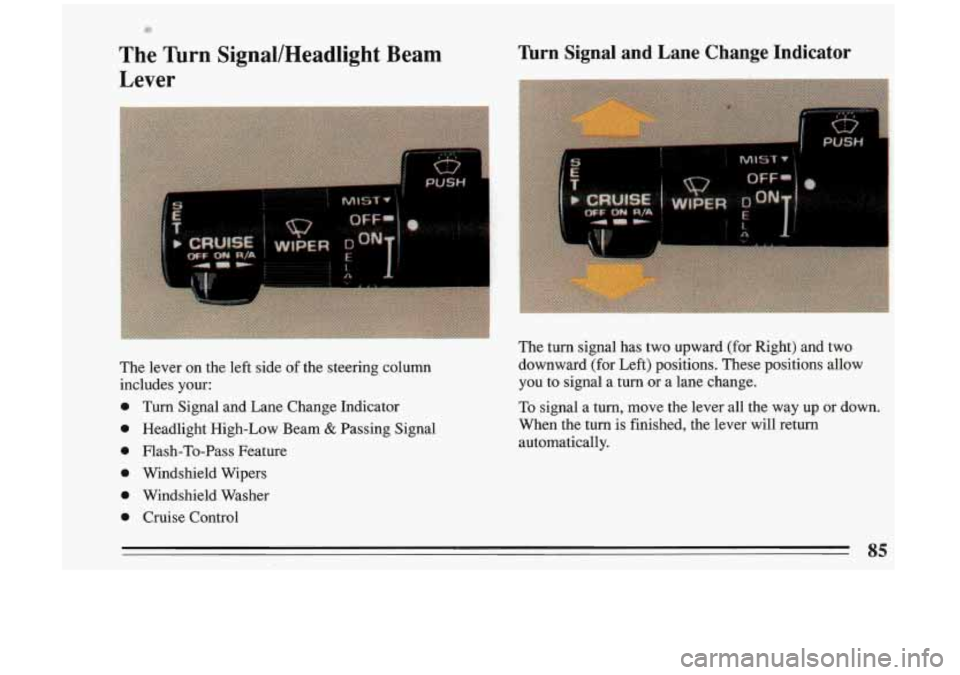
1Ai
The Turn SignallHeadlight Beam
Lever nrn Signal and Lane Change Indicator
The lever an the left side of the steering column
includes
your:
0 Turn Signal and Lane Change Indicator
0 Headlight High-Low Beam & Passing Signal.
0 Flash-To-Pass Feature
6 Windshield Wipers
0 Windshield Washer
0 Cruise Control The turn signal has two upward (for Right) and two
downward (for Left) positions. These positions allow
you to signal a turn or a lane change.
To signal a turn, move the lever all the way up or down.
When the turn is finished, the lever will return
automatically.
85
Page 154 of 324
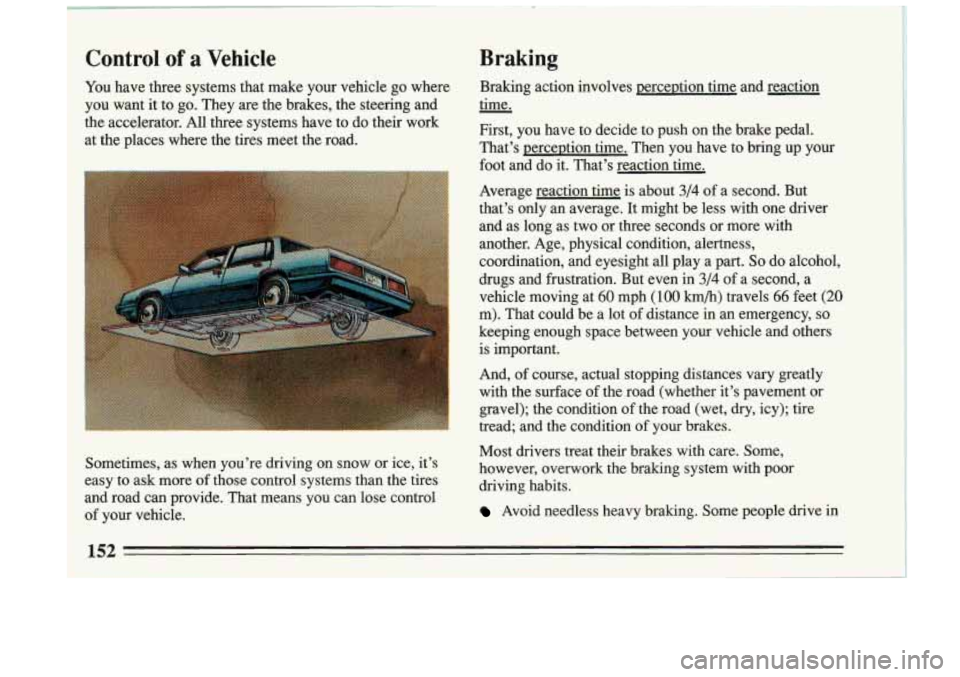
Control of a Vehicle Braking
You
have three systems that make your vehicle go where Braking act\
ion involves perception time and reaction
you want it to go. They are the brakes, the steering and time.
the accelerator. All three systems have to do their work First\
,
you have to decide to push on the brake pedal,
at the places where the tires meet the road.
That’s perception time. Then you have to bring up your
foot and do
it. That’s reaction time.
Average reaction time is about
3/4 of a second. But
that’s only an average. It might be less with one driver
and as long as two or three seconds or more with
another. Age, physical condition, alertness,
coordination, and eyesight all play a part.
So do alcohol,
drugs and frustration. But even in
3/4 of a second, a
~ vehicle moving at 60 mph (100 km/h) travels 66 feet (20
m). That could be a lot of distance in an emergency, so
keeping enough space between your vehicle and others
is important.
Sometimes, as when you’re driving on snow or ice, it’s
easy to ask more
of those control systems than the tires
and road can provide. That means you can lose control
of your vehicle.
~ And, of course, actual stopping distances vary greatly
with the surface of the road (whether it’s pavement or
gravel); the condition
of the road (wet, dry, icy); tire
tread; and the condition of
your brakes.
Most drivers treat their brakes with care. Some,
however, overwork the braking system with poor
driving habits.
Avoid needless heavy braking. Some people drive in
152
Page 159 of 324
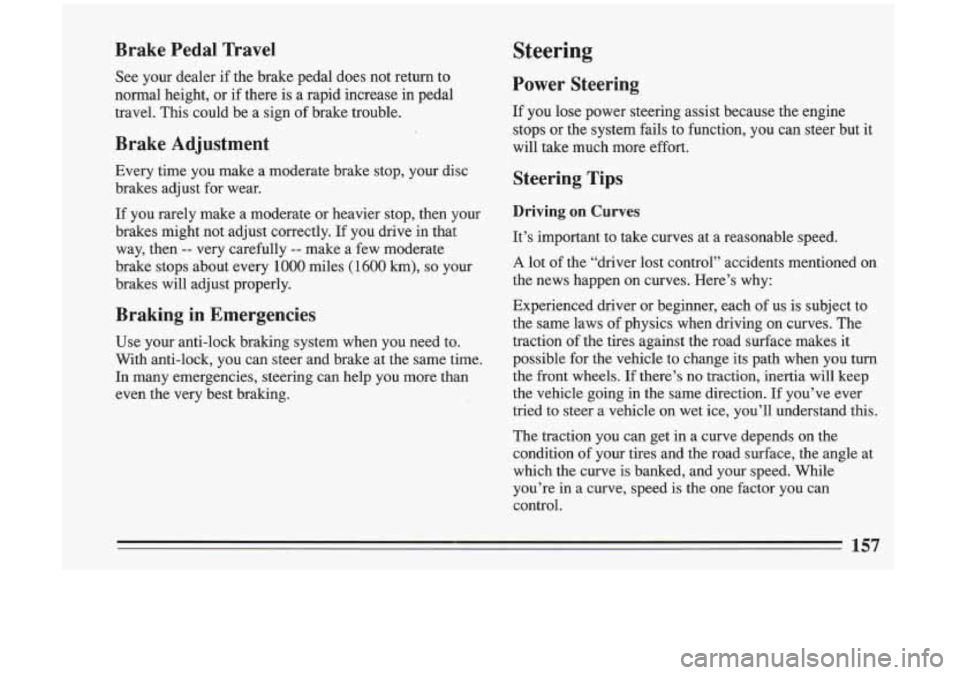
Brake Pedal Travel
See your dealer if the brake pedal does not return to
normal height, or if there is a rapid increase in pedal
travel. This could be
a sign of brake trouble.
Brake Adjustment
Every time you make a moderate brake stop, your disc
brakes adjust for wear.
If you rarely make a moderate or heavier stop, then your
brakes might not adjust correctly.
If you drive in that
way, then
-- very carefully -- make a few moderate
brake stops about every
1000 miles ( 1600 km), so your
brakes will adjust properly.
Braking in Emergencies
Use your anti-lock braking system when you need to.
With anti-lock, you can steer and brake at the same time.
In many emergencies, steering can help you more than
even the very best braking.
Steering
Power Steering
If you lose power steering assist because the engine
stops or the system fails to function, you can steer but it
will take much more
effort.
Steering Tips
Driving on Curves
It’s important to take curves at a reasonable speed.
A lot of the “driver lost control” accidents mentioned on
the news happen on curves. Here’s why:
Experienced driver or beginner, each of us is subject to
the same laws of physics when driving on curves. The
traction
of the tires against the road surface makes it
possible for the vehicle to change its path when you turn
the front wheels.
If there’s no traction, inertia will keep
the vehicle going
in the same direction. If you’ve ever
tried to steer a vehicle on wet ice, you’ll understand this.
The traction you can get in a curve depends on the
condition of your tires and the road surface, the angle at
which the curve is banked, and your speed. While
you’re in a curve, speed is the one factor you can
control.
157